
Hi Gang…
What grabbed you and your fiberglass car interest? For me….it’s all about design. Beauty is in the eye of the beholder and what I see…”I get.” Most of my far more schooled friends in car design have been patient with me as they’ve taught me about chassis builds, engine types, transmission choices, front end setups, and such. I’ll say it again…
“For me…it’s all about design…”
And Strother MacMinn’s LeMans Coupe takes my breath away. It did so from the first time I saw it in print. So…let’s talk “LeMans Coupe” and “Mac” – what his friends called the designer, stylist, visionary, and teacher throughout his life.
The Legend Begins….So Does Research Too
I first met Harold Pace, noted sports car historian, back in 2006. During phone calls and e-mails, he told me about a legendary car – the LeMans Coupe – one of which had been found back in the 1990’s. “How many of these are out there?” I asked Harold. That’s the only one we know of…
Aw shucks….but what a great looking car. “Where was it” I asked? It was found in California and never heard of again. I love mysteries…ambiguity is not a friend of mine for long, so off I started on the quest for more information.
Sports Car Guide: March 1960
From The Drawing Board, by Robert Cumberford
In order to do the best research possible, I’ve been collecting magazines to get first hand account of all cars in the ’50s and ‘60s. And…when a rare 1960 copy of “Sports Car Guide” landed on my doorstep…I could hardly wait to see what was inside. This was a tough magazine to find! Just 4 issues/months were printed and then it vaporized…never to be seen again. Almost sounds like a fiberglass car gang – doesn’t it???
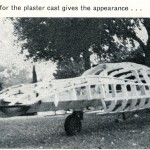
Caption: Mockup for the plaster cast gives the appearance of a wingless aircraft fuselage or high speed boat.
Inside the magazine, I found a column called “From the Drawing Board”, by Robert Cumberford, and reference to 4 very special cars. Here’s how Robert’s column started that month:
“In months to come this column will be devoted to critical analysis of sports car design – from the outside in. It is my firm belief that to be worthy of the name, a sports car must first of all be good looking. Let me enlarge a bit by giving my own definition of just what “good looking” means: a good-looking car is one whose visual presence commands some sort of emotional response.
The modest, bland, contemporary nonentity, product of the designer’s failure of nerve, must be condemned along with the excessive and gaudy product of his failure of taste. This time I want to discuss four designers whose work I consider the most impressive of the past ten years.”
What a wonderfully written way to describe the beauty of style done right. Cumberford went on to review the Lotus 11, BMW 507, BAT VII, and Mac’s LeMans Coupe. Let’s see what he had to say about the car we are discussing today:
Strother MacMinn / LeMans Coupe
“Strother MacMinn is a California industrial designer who spends a good part of his time teaching young designers the rudiments of their trade. He learned to draw cars on Saturday mornings at the Murphy bodyworks in Pasadena, and was a professional automobile designer long before he could vote.
Now, after more than twenty years the first car built to his designs has appeared – a Corvette powered coupe based on drawings which were featured in a magazine! No matter; this is the most exciting sports-car design actually constructed in the United States in years.
Its elegance and high style enhance rather than detract from overall performance. Correct aerodynamically, the body shape puts to shame anything else which has been constructed for the Chevrolet V-8 engine, including the best efforts of General Motors. This is not too suprising. MacMinn taught many of the GM designers most of what they know.”
So..after reading the article above, I found the article Cumberford was referencing on the car – Road & Track, August 1960. Let’s have a look:
Sports Car Design Realized: Road & Track, August 1960
When John Bond, publisher of Road & Track. began to visualize an ideal American car to compete at Le Mans, he based his hypothesis on the idea that possibly someone of limited means but immense ambition would build it. Under the title of Sports Car Design and as No. 39 in that series, the description commenced in November 1957, and ran through the January, February, and April issues of 1958, with a complete analysis of structure, detail, accommodation, and body form, all carefully coordinated toward creating a serious contender for the famed 24-hour race. Chassis components were all derived from available manufactured items, with the exception of the frame itself, and this custom-fabricated item was kept as simple and inexpensive as possible, being merely two parallel box-section rails.
A number of people wrote, expressing definite interest in attempting the project, and the series of articles actually did trigger three dedicated Southern California enthusiasts into action. Marvin Horton, an electronics technician for a ram-jet manufacturing corporation, father of three, and a solidly qualified amateur sports car engineer, had long had dreams of an ideal sports competition car that was far from anything offered by current manufacturers. Although his chassis concept differed somewhat from Bond’s, he felt that the general body envelope suited his purpose very well, an opinion shared by friend and electronics co-worker Ed Monegan, whose long experience in high-speed boat building was to provide invaluable.
Using the published body drawings as a rough basis, they completed a full-size lines loft in June of 1958 and began a wood frame for the male body plug, which was three-quarters complete in August, when they contacted the author. A clay model that had been used as a basis for the design was transferred to Horton’s Pacoima home where the work was being done. In consideration of the high-speed runs to be attempted with the car, Horton decided to raise progressively the rear of the body, beginning amidships, in order to cancel more of the top surface negative pressure behind the cab, and add more in the underpan area.
This change, accomplished in the wood frame stage, resulted in an upswept “platform line” crease on the body’s side, but provided a more efficient tail conformation. Clay, as a mold plug medium, was prohibitively expensive, so plaster was used to fill in the frame. It took several months to refine the surfaces and general shape with a grinder, primer, putty, and endless hours of patient work.
About February of 1959, Alton Johnson, another enthusiast with real and individual ambitions and extensive fiberglass experience with the Victress Manufacturing Company, had nearly completed a chassis of his own, with dimensions coincidentally close to the original Bond idea. He contacted Horton, and it was agreed that for his help in finishing the body plug and mold he would receive the first shell.
The mold was completed by June of 1959, and a superlight basic body form, sans windows and rear wheel cutouts, was cast and transferred to Johnson’s operation area at Victress.
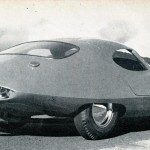
The Rear Styling of The LeMans Coupe Is Right On. Bob Gurr, one of Mac’s Friends, Told Me That Mac’s Inspiration For The Car Was The Talbot Lago – One Of His Favorite Coupes. He Had Spied One On Display On Sunset Blvd In The 1950’s.
Horton then returned to his own chassis fabrication, which was completed and running by February of 1960, having been delayed by an Olds engine installation in a Studebaker and a compete one-off Formula Junior project. On the coupe, he elected to use wishbones and longitudinal torsion bars (machined from pre-1949 Ford driveshafts) for the front suspension, but a transverse leaf spring (as suggested in the article) provided weight support for the independent rear. A space-tube frame, tied in with a structural aluminum reinforced fiberglass driveshaft shaft tunnel provided the lowest possible seating between side members, and a firm body mounting. His program is due for completion about mid-summer of this year.
Johnson had his own chassis enclosed in the first body by August of 1959, when it was possible to run an airflow observation test at the Riverside International Raceway. White wool tufts for determining air-flow direction were easily visible against the dark grey primer, and sections that had already been cut out of the body for the two headlight tunnel openings were carefully taped back into place to provide a completely smooth form.
Howard Miereanu (now a General Motors designer, but then a student at the Art Center School in Los Angeles), possessor of a Bolex 16-mm motion picture camera, was perched in the passenger seat of an accompanying car and panned past the coupe which was run at steady speeds of 60, 70, 80, 90, and 100 mph down the 5,100-ft back straight of the race course. Viewing this film at slow speed later confirmed theories that some of the top boundary layer could be diverted around the corners of the cab by use of a sharply peaked cowl and windshield, and that the general air flow was true to the developed contours with a minimum of turbulence.
One of the world’s greatest automotive aerodynamicists, upon analyzing a still picture of this test, expressed concern over the sharp edges of the fender sections as a barrier to smooth cross-flow, and the obvious desirability of a complete undertray (which Johnson’s car did not have), but satisfaction with the flow behavior around the cab.
Johnson has since built an entirely new chassis for his car, using the original Chevrolet engine, but an all-independent wishbone suspension with coil springs, and disc brakes, all of which should be covered by a revised version of the original body by mid-summer.
Since Horton’s “original” car will probably be licensed about the same time, or possibly earlier, it should make this dual culmination of Bond’s far-reaching suggestion a most exciting reality.
Thoughts on the Article:
Good friend Gary Smith from Dean’s Garage also covered this car and received some very interesting comments at the bottom of the story. Click here to review the story of the LeMans Coupe on Dean’s Garage, and be sure to scroll down and review the comments to put the car in perspective for its time.
The full story of the LeMans Coupe involves friends and support at Victress, and we’ll have much more to share in the future about this car and how it was built. In addition….this wasn’t the only group attempting to build this car. There was another entire group building their own version of the LeMans Coupe and we’ll be sharing their success in the future in another story here at Forgotten Fiberglass.
Summary:
So how many of Mac’s LeMans Coupes survive?
That’s a great question! The one in California is no doubt still out there. I found another on Ebay. A third “body only” surfaced in California, and a fourth one was found in Minnesota. And more may be rearing their heads soon.
I’m hot on the trail of two – maybe three more – that have left tantalizing clues as to their whereabouts. Time will tell. And…I’ve heard rumors recently that Mac’s LeMans Coupe body may be “re-popped” and offered again for sale – for the first time in over 50 years.
Perhaps the time has come for the Strother MacMinn’s LeMans Coupe, after all.
Hope you enjoyed the story, and until next time…
Glass on gang…
Geoff
——————————————————————-
Click on the Images Below to View Larger Pictures
——————————————————————-
- Caption: Gull wing doors facilitate entrance in low body design.
- The Rear Styling of The LeMans Coupe Is Right On. Bob Gurr, one of Mac’s Friends, Told Me That Mac’s Inspiration For The Car Was The Talbot Lago – One Of His Favorite Coupes. He Had Spied One On Display On Sunset Blvd In The 1950’s.
- Caption: Spring wheel and instrument cluster can be seen here.
- I’ve Always Loved The Design and Look Of This Car – Conceived and Drawn in 1957!
- Caption: Mockup for the plaster cast gives the appearance of a wingless aircraft fuselage or high speed boat.
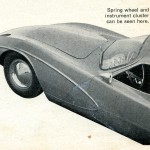
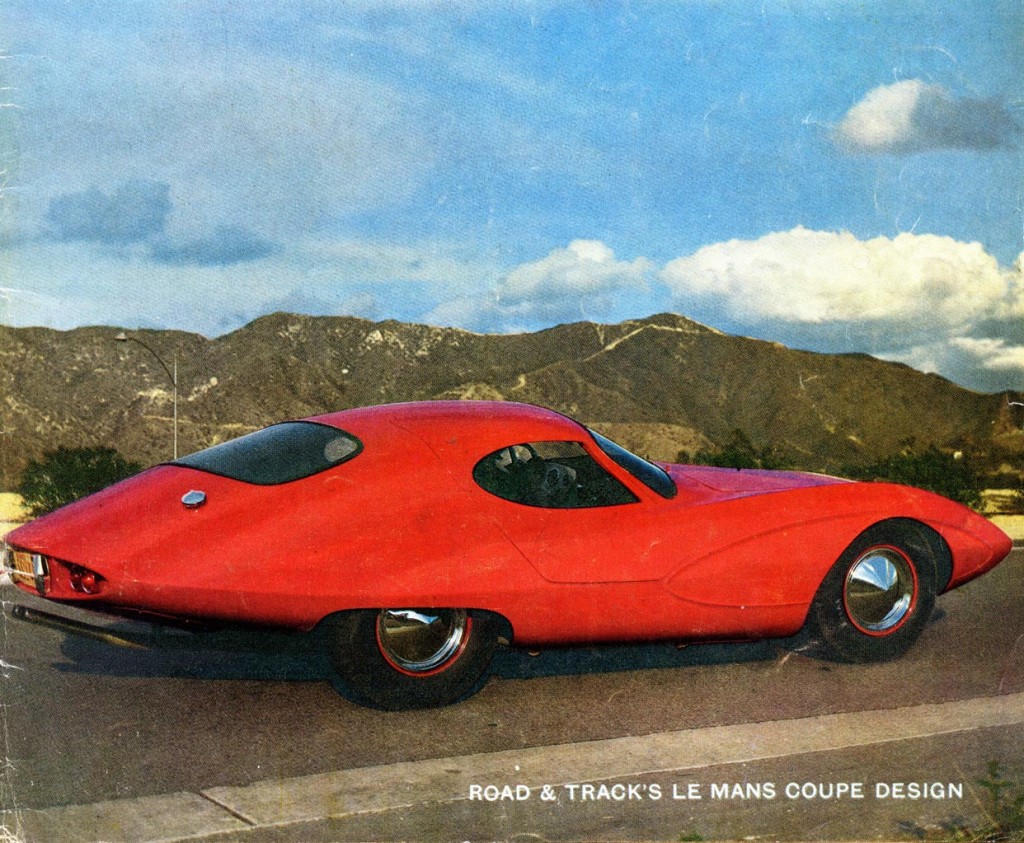
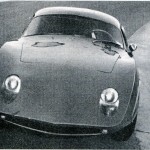
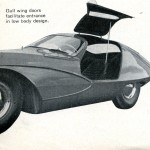






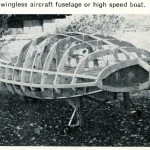
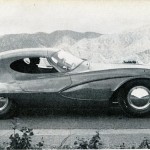
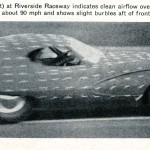


Hi Tom…
Thanks for sharing. That’s the latest in a string of these cars that have been found. I think we’re up to 6 or so LeMans Coupe cars being found, and I have a lead on two more I’ve been tracking down.
Fun, fun, fun!
Keep the comments coming…
Geoff
An original unfinished LeMans Coupe competition body and chassis in Minnesota was recently for sale in Hemmings magazine.
http://www.hemmings.com/classifieds/carsforsale/american/unspecified/1277797.html
http://marsmicro.com/lemans/
Tom in Detroit
Somewhere I’ve got a pic of a dragster version of this car. Looks like they mounted it on an early funny car chassis. Never new what it was until now.
I remember Mac talking about helping with the final surface development. John Bond likely was involved with the Riverside run, too. And, remember Mac’s dad taught at Cal Tech. Some smoke and wind tunnel tests were done on his designs – likely there.
I really enjoyed the articles. It was interesting that there was no mention of the fact that Mac monitored the progress of the mockup, and made suggestions and adjustments to the original design as construction progressed. I recall a minor change in the windshield area to accommodate available glass. Later, he dropped by Victress to check on Alton’s progress. I’m guessing that he also orchestrated the speed runs at Riverside, given that the camera work was by an Art Center student.
Strother McMinn was a great friend to the auto industry through schooling future stylists, to the car hobby both speaking at significant club events and judging at concours and through his own personality and character which were exemplary. It was an honor to meet him. Had things been different, there is no one I would have rather had teach me “to draw”.
I know someone who would love to get one of these cars!!!!! I have some pictures we found of my grandfathers coupe. I will scan them and send them to you if I can remember
Thanks for the article,